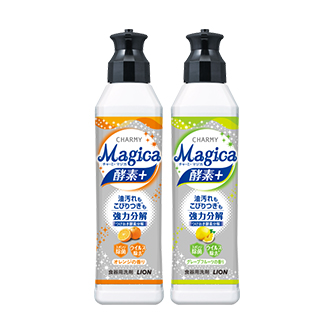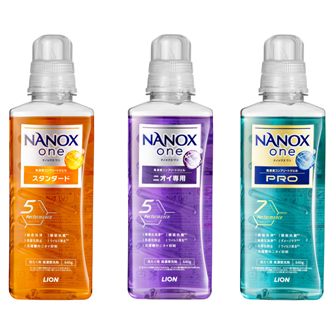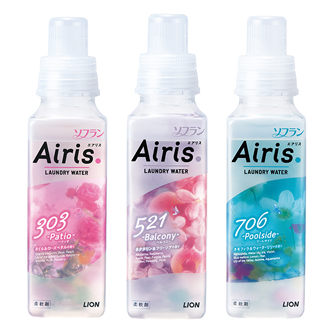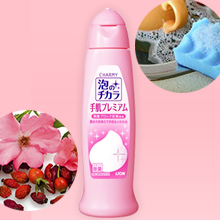When doing laundry at home, in addition to using detergent to wash clothing, approximately 80%*1 of consumers use fabric softener to maintain clothing texture. A Lion survey found that, on top of the usual demand for softness, in recent years, consumers are increasingly looking for fabric softeners that impart a smoothness that ensures clothing glides across the skin.*2 This tendency is especially strong for clothing that tends to get viscous due to sweating over the course of a day, such as tops and underclothes.
In light of these needs, Lion assessed a wide range of texture-related additives with the aim of developing an unprecedented kind of fabric softener that imparts a noticeably smooth, non-clingy feeling to clothing not only when it is dry, but even when it is wet, such as after sweating. As a result, we found that a proprietary silicone ingredient developed by Lion (“Silicone A”) offered an outstanding smoothing effect. Aiming to better understand the factors behind the smoothing effect of Silicone A, particularly focusing on wet conditions, such as after sweating, when the need for non-clingy smoothness is even higher, we analyzed the effects of Silicone A on the surface of clothing fibers.
*1 Lion survey (September 2022, n=2,000)
*2 Lion survey (June 2021, n=842)
Assuming that consumers particularly notice the texture of clothing when it is in direct contact with the skin and especially when a hand is run over the surface, we measured the surface viscosity of a clothing sample treated with a fabric softener formulated with Silicone A*3 and of a film made of Silicone A. One method of assessing the physical properties of the surface of clothing is to measure surface viscoelastic property with a rigid-body pendulum test. Normally, when the clothing surface that the rigid-body pendulum touches has high viscosity, the resulting resistance causes a rapid damping (reduction) of its amplitude of oscillation; conversely, when the sample surface has low viscosity, damping is slower, and the surface is therefore expected to present less of a feeling of resistance to users (Figure 1). In this experiment, surface viscosity was assessed based on the logarithmic damping rate of the pendulum oscillation amplitude.
The results indicated that the clothing treated with the Silicone A fabric softener had lower surface viscosity than the clothing treated with a cationic surfactant, a conventional softening agent used in fabric softeners (Figure 2). The surface viscosity of films made of each of these ingredients was also measured, revealing that, while Silicone A retained its non-clingy nature in the presence of moisture, the cationic surfactant formed a gel with moisture, resulting in increased viscosity (Figure 3). Based on these results, we surmised that Silicone A achieves a smooth, non-clingy feeling because it does not mix with moisture on the clothing surface, thereby preventing an increase in clothing surface viscosity due to the presence of moisture, such as that due to sweat.
*3 For this experiment, water was sprayed on the samples in an amount that simulated wetting due to sweat



We assessed the water absorbency of Silicone A based on the assumption that when sweat is absorbed into the inner structure of clothing, clothing would be less prone to sticking to the skin, and that this might help achieve a smooth, non-clingy texture. As a result, we found that clothing treated with Silicone A exhibited faster water absorption than clothing treated with the cationic surfactant (Figure 4). Based on this finding, we expect that, compared with clothing washed with a conventional cationic surfactant fabric softener, clothing washed with a Silicone A fabric softener will absorb moisture on the clothing surface more quickly and therefore better maintain a smooth, non-clingy feel when wet, such as after sweating.

Lion has developed SOFLAN Airis, a fabric softener formulated with Silicone A to impart a smooth, non-clingy feel to clothing. Going forward, we will use surface analysis technology to further develop the technology for imparting desired textures to clothing established through this research and offer products that are closely aligned with the everyday living habits of our customers.

Related News Release
Reduces Clothing Cling by Approximately 20%! Lion Develops New Technology for Imparting a Smooth Feel to Clothing

Development of CHARMY Magica Enzyme+ (“Plus”), a dishwashing detergent that uses a proprietary blend of enzymes to break down stubborn oily grime

Development of Cleaning Technologies (Detergency, Deodorizing Power, Protection from Yellowing) for NANOX one

SOFLAN Airis Fabric Softener, Providing a Smooth, Non-Clingy Feel When Wet, Such As After Sweating

Dishwashing Detergent Developed with a Focus on Skin Moisture:CHARMY Awa no Chikara (Power of Suds) Hand Premium

Heyaboshi (Hang-to-Dry Indoors) TOP—Prevents Odors Even During Laundry Use
Related Information